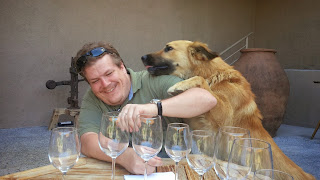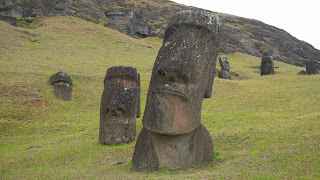Even though the climate is harsh and cold, the indigenous people mostly ran around naked - apparently undisturbed by the low temperatures as opposed to their western counterparts freezing under heavy blankets. Over time the locals have developed a higher metabolism than people in warmer territories - causing their internal body temperature to be higher than normal. Apart from this they also had special techniques to combat the cold, including sleeping in a squatted position and in this way reducing how they were exposed to the cold. Another trick was to cuddle up to eachother around small campfires, which is the reason this southernmost province of Argentina got it's name - Tierra del fuego (land of fire). The picture below shows a typical camp from the early inhabitants of the area:
Tierra del Fuego, was one of the last parts of South America to be inhabited by westerners and got its name from the many campfires seen by early western explorers when they first came to the area. The British were the first to settle here, and even after Argentina got its independence, the area was still not under Argentinian sovereignity.
Ushuaia was founded in 1884 and centered around a prison built by the Argentine government to increase the Argentine population here and this way ensure their sovereignity over the province. Following the French example from Devil's Island (French Guyana), and the British in Tasmania (Australia) they created this prison intended for repeat offenders and serious criminals. And just as in Australia the prison population became some kind of "forced colonists", spending much of their time building the city and its infrastructure. They even built a railway from the prison to the settlement which is now a tourist attraction - Tren del Fin del Mundo (End of the world train). The old prison itself is now also a tourist attraction; turned into a museum after being closed in 1947 following many reports of abuse and unsafe practices.
Arriving in Ushuaia came as bit of a shock to all of us. The sub-zero temperatures and falling snow hit me quite hard wearing shorts and t-shirt disembarking the plane after 3 weeks in hot climates. "Excuse me, are you not freezing?" came from a group of americans stating the obvious, and we were quick to book a cab and get to our hostel to change clothes.
The weather prevented us from exploring too much outside on the first day in Ushuaia. Earlier on the trip we stayed a few days at the world's highest located city and got to check in at many "world's highest" venues. This time we did the same thing over again just that now it was "world's southernmost". We spent the day exploring the city and its many shops and cafes and planning ahead for the following day.
Rising early me and Lars were not able to wake up Chris even after repeated attempts. As our ride was leaving we decided to give it up, and off we went in the snow and cold. Our goal for the day was the #1 attraction in Ushuaia - the Tierra del fuego national park, and the train at the end of the world!
Arriving at the station we decided to go for the Premium tickets that included "comfort" seating, seafood sandwiches and a glass of champagne. We also got a little gift included in this offer that proved to be a 2013(!!!) calendar with pictures of the railway. Why they hadn't changed this into a 2014 calendar remains a mystery to me as the date we received this gift was november 27 - just a month away from turning into the new year.
The train was extremely small - the tracks just 50cm between them. Our premium carriage seated two persons beside each other while one had to cuddle up 3 and 3 in the coach class. Boarding the train the weather cleared up in a blink giving us blue sky and sunshine as we rolled into the national park. Our local guide showed us around and told us about birds and flowers and we got tons of good pictures. At least me and Lars as Chris was still in bed..
After a tour around the park, a run at the southernmost railway in the world and some good photo opportunities we returned to Ushuaia. Chris, who by then had been woken up, was found sleeping on a couch as he had to check out of his room and couldn't continue sleeping in his bed. There are ofcourse some hilarious pictures following this story but it's not something for sharing on the web. ;-)
Grabbing our gear and strolling down to the port we got ready and eager to start the part of our trip which was the main reason for going to south America in the first place - the voyage across the Drake passage to Antarctica, the final continent. Our boat is the M/S Expedition with the red hull at the end of the pier:
Boarding the ship, this is a picture looking back at Ushuaia from the top deck one last time before leaving civilization behind:

















































